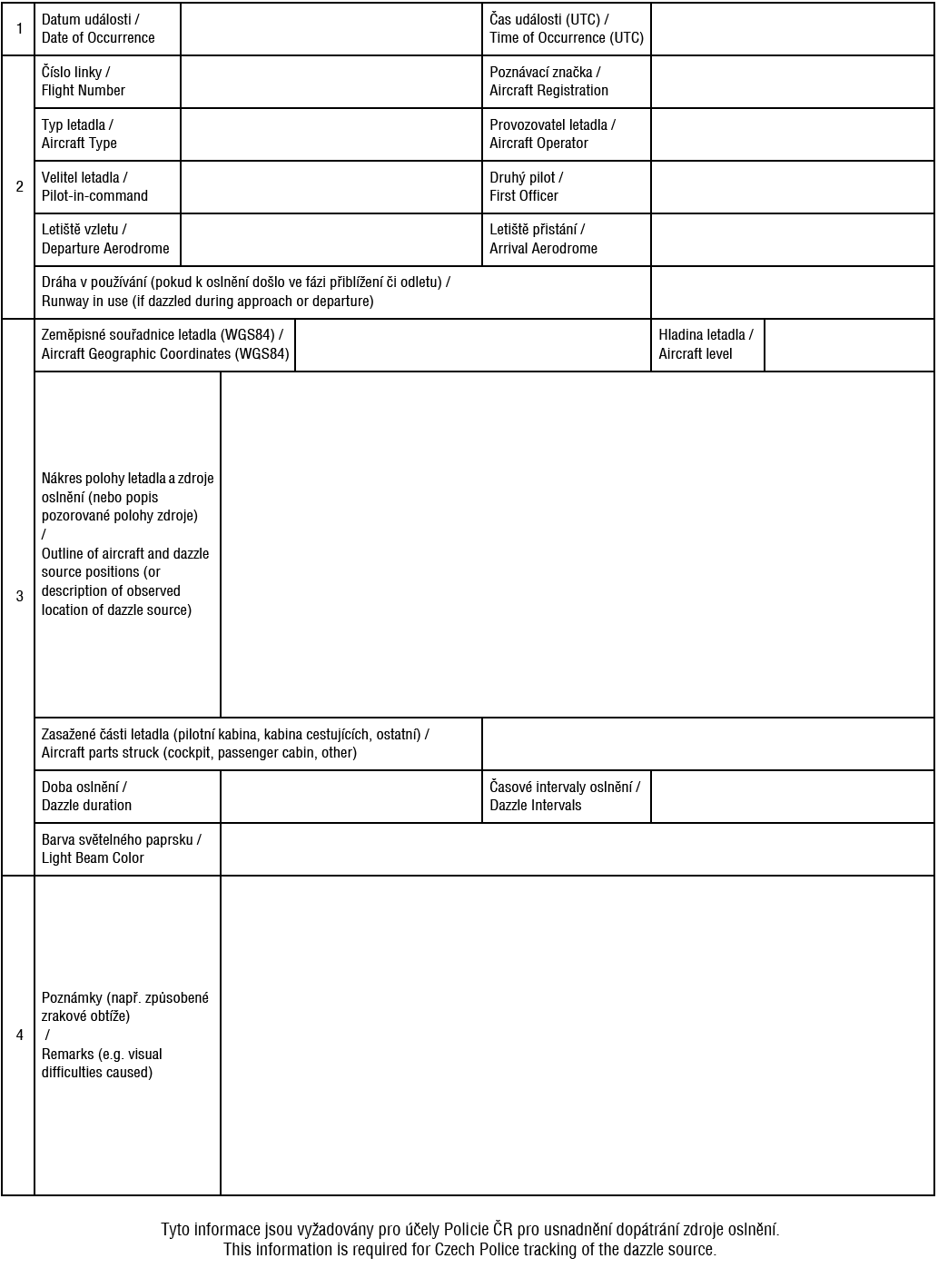ENR 1.14 Air traffic incidents
1.14.1 Definition of air traffic incidents
aircraft proximity (AIRPROX)
serious difficulty resulting in a hazard to aircraft caused, for example, by:
faulty procedures
non-compliance with procedures, or
failure of ground facilities
1.14.1.1.1 Definitions for aircraft proximity and AIRPROX
Aircraft proximity: A situation in which, in the opinion of the pilot or the air traffic services personnel, the distance between aircraft, as well as their relative positions and speed, has been such that the safety of the aircraft involved may have been compromised. Aircraft proximity is classified as follows:
Risk of collision. The risk classification of aircraft proximity in which serious risk of collision has existed.
Safety not assured. The risk classification of aircraft proximity in which the safety of the aircraft may have been compromised.
No risk of collision. The risk classification of aircraft proximity in which no risk of collision has existed.
Risk not determined. The risk classification of aircraft proximity in which insufficient information was available to determine the risk involved, or inconclusive or conflicting evidence precluded such determination.
AIRPROX. The code word used in an air traffic incident report to designate aircraft proximity.
| Typ | Označení | Type | Designation | |
Incident v letovém provozu | Incident | Air traffic incident | Incident | |
jako v a) výše | AIRPROX | as a) above | AIRPROX | |
jako v b) 1) a 2) výše | Nesprávný postup | as b) 1) and 2) above | Procedure | |
jako v b) výše | Porucha zařízení | as b) 3) above | Facility |
1.14.2 Use of the Air Traffic Incident Report Form (See model on pages ENR 1.14−5 to 1.14−9)
The Air Traffic Incident Report Form is intended for use:
-
by a pilot for filing a report on an air traffic incident after arrival or for confirming a report made initially by radio during flight.
Note: The form, if available on board, may also be of use in providing a pattern for making the initial report in flight.
-
by an ATS unit for recording an air traffic incident report received by radio, telephone or teleprinter.
Note: The form may be used as the format for the text of a message to be transmitted over the AFS network.
1.14.3 Reporting procedures (including in-flight procedures)
during flight, use the appropriate air/ground frequency for reporting an incident of major significance, particularly if it involves other aircraft, so as to permit the facts to be ascertained immediately,
as promptly as possible after landing, submit a completed Air Traffic Incident Report Form
for confirming a report of an incident made initially as in a) above, or for making the initial report on such an incident if it had not been possible to report it by radio,
for reporting an incident which did not require immediate notification at the time of occurrence.
aircraft identification,
type of incident, e.g. aircraft proximity,
the incident: 1. a) and b),
2. a), b), c), d), n),
3. a), b), c), i),
4. a), b),
miscellaneous: 1. e).
Civil Aviation Authority
K letišti 1149/23
161 00 Praha 6
Air Accidents Investigation Institute
Beranových 130
199 01 Praha 99 - Letňany
or to the ATS Reporting Office of the aerodrome of first landing for submission to the Civil Aviation Authority of the C.R.
The pilot should complete the Air Traffic Incident Report Form, supplementing the details of the initial reports as necessary.
Note: Where there is no ATS Reporting Office, the report may be submitted to another ATS unit.
1.14.4 Purpose of reporting and handling of the form
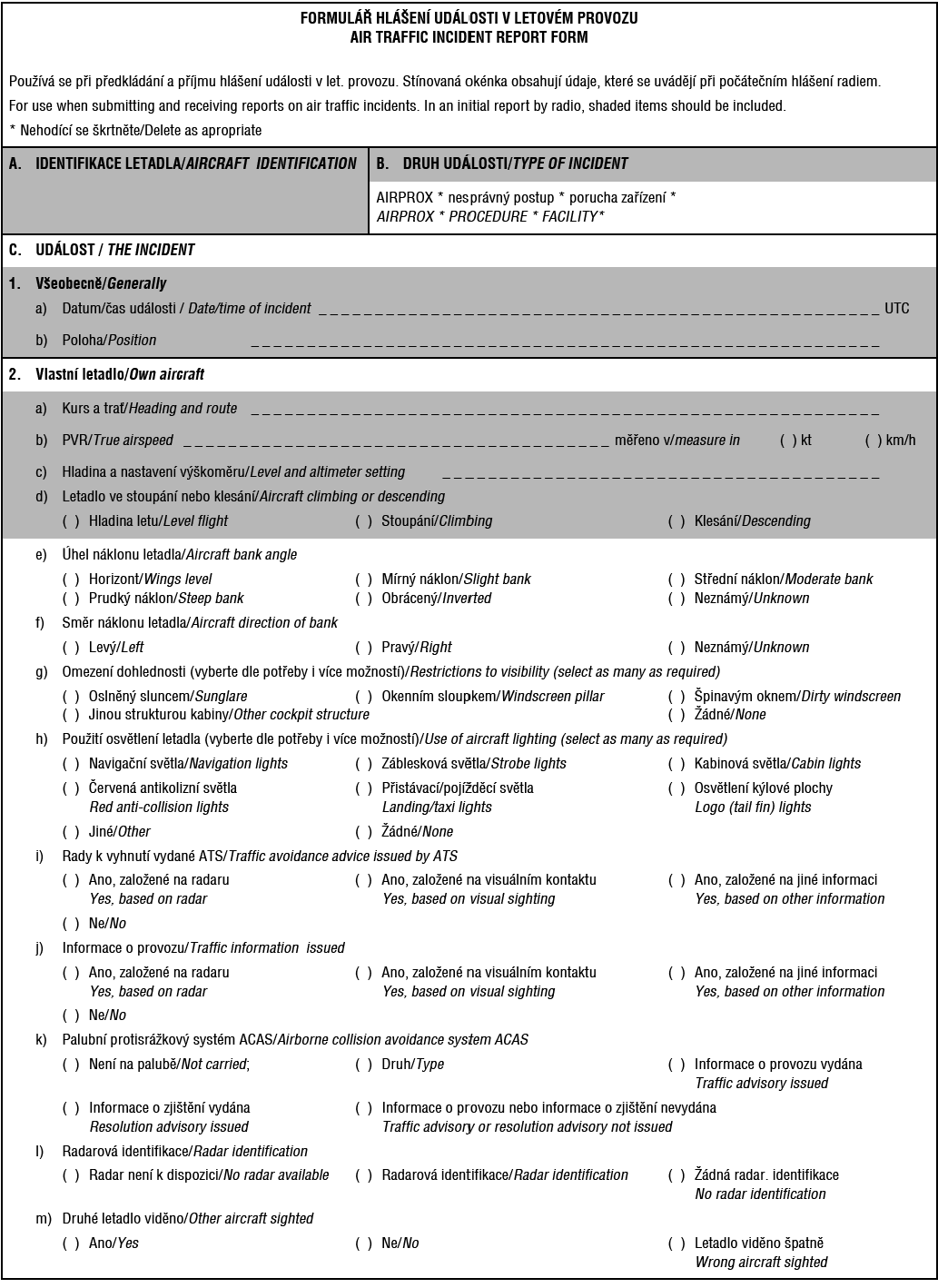
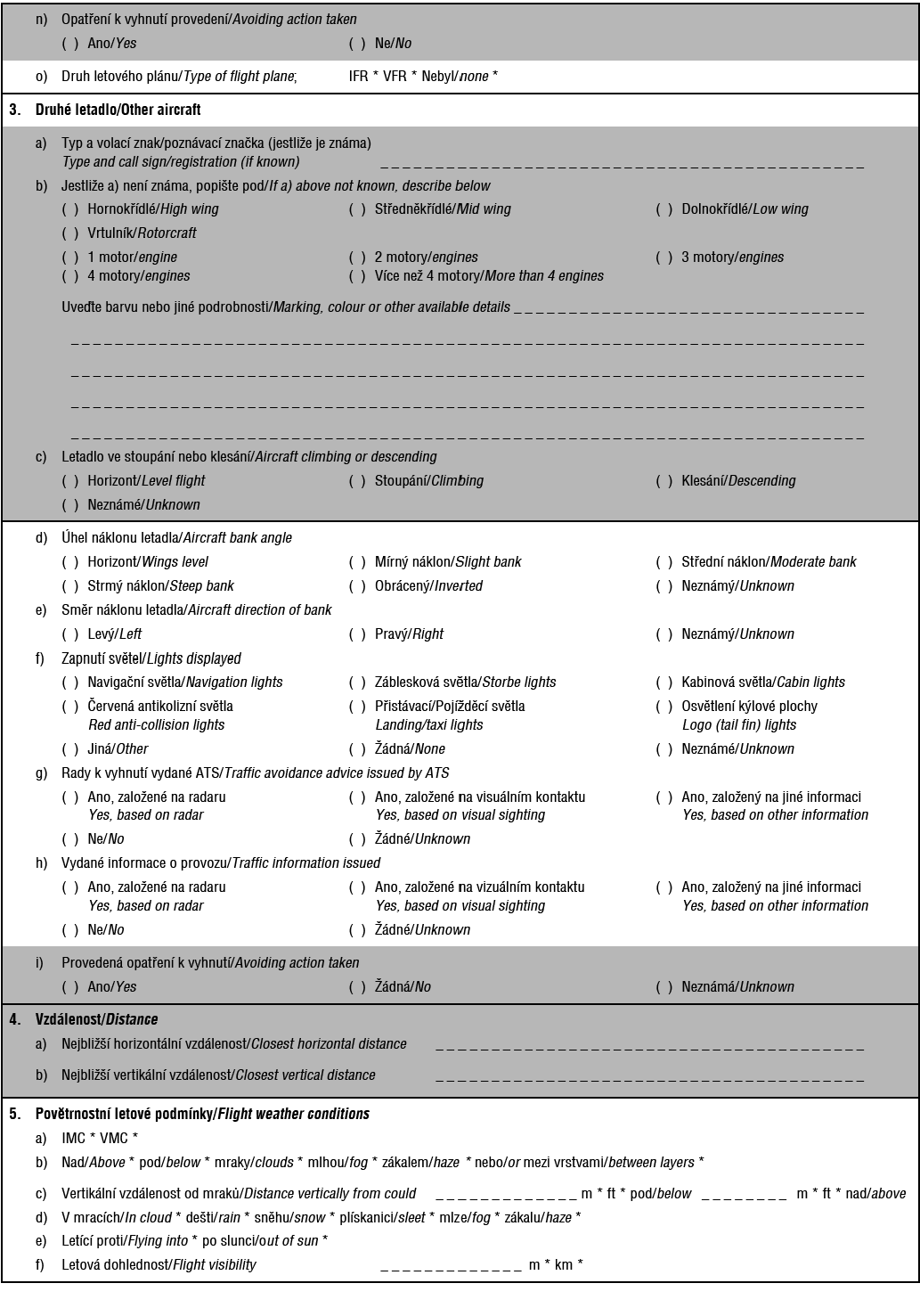
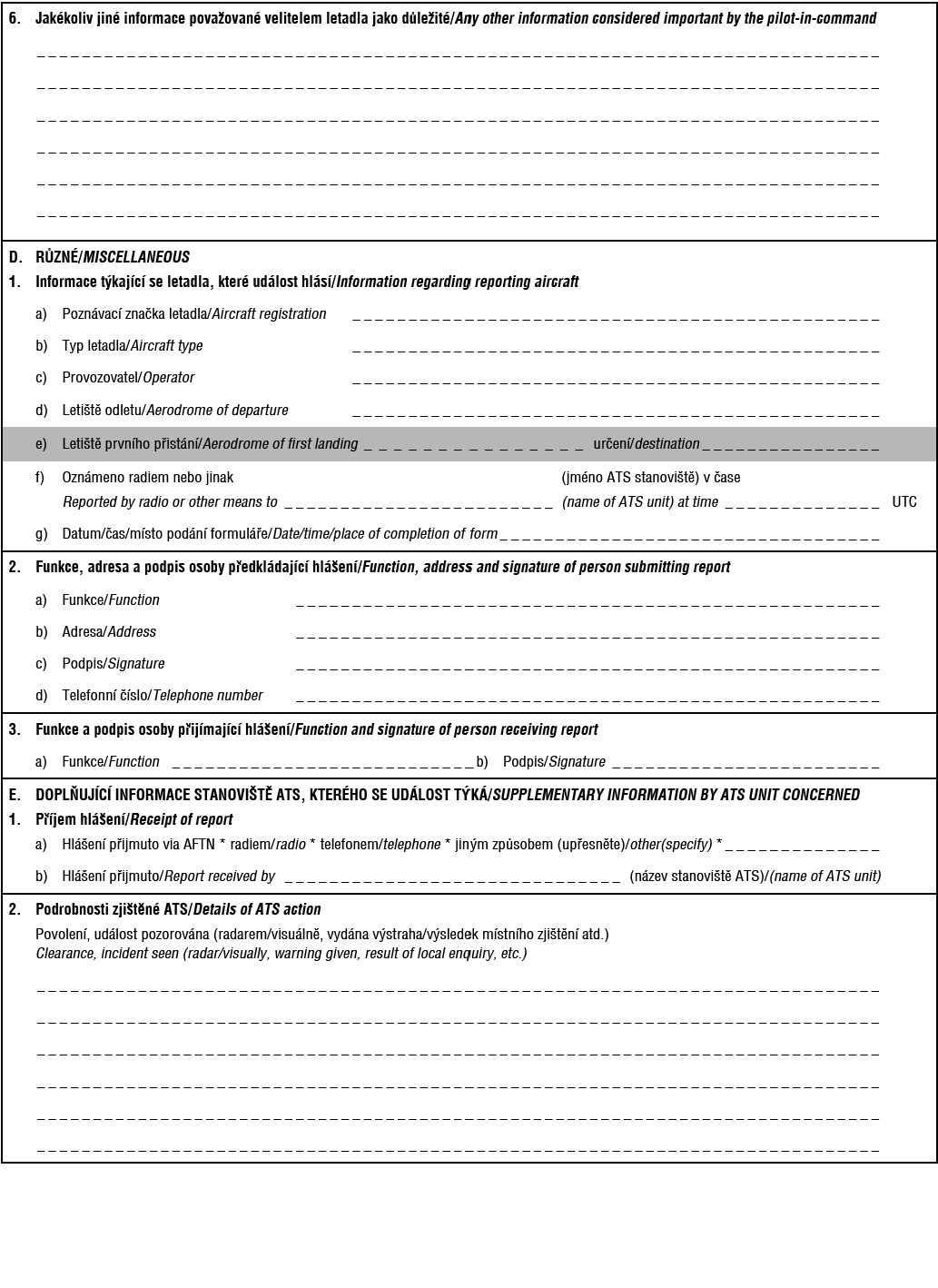
DIAGRAMS OF AIRPROX
Mark passage of other aircraft relative to you, in the plan on the left and in elevation on the right, assuming YOU are at the centre of each diagram. Include first sighting and passing distance.

Instructions for the completion of the Air Traffic Incident Report Form:
-
A Aircraft identification of the aircraft filing the report.
-
B An AIRPROX report should be filed immediately by radio.
-
C1 Date/time UTC and position in bearing and distance from a navigation aid or in LAT/LONG.
-
C2 Information regarding aircraft filing the report, tick as necessary.
-
C2 c) E.g. FL 350 / 1013 hPa or 2500 ft / QNH 1007 hPa or 1200 ft / QFE 998 hPa.
-
C3 Information regarding the other aircraft involved.
-
C4 Passing distance − state units used.
-
C6 Attach additional papers as required. The diagrams may be used to show the aircraft’s positions.
-
D1 f) State name of ATS unit and date/time in UTC.
-
D1 g) Date and time in UTC.
-
E2 Include details of unit such as service provided, radiotelephony frequency, SSR Codes assigned and altimeter setting. Use the diagram to show the aircraft's position and attach additional papers as required.
1.14.5 EUROPEAN RVSM WAKE VORTEX REPORT
1.14.5.1 Wake vortices in EUR RVSM Airspace
Any pilot who encounters a wake turbulence incident when flying in EUR RVSM Airspace or within an adjacent RVSM transition area should ensure that a detailed report is provided to EUROCONTROL and State Regulation Authorities using the attached report form.
1.14.5.2 Wake vortex encounters
Pilot actions
When an aircraft is operating in the EUR RVSM Airspace and encounters severe turbulence due to weather of wake vortex, and the pilot-in-command believes the vertical navigation performance requirements for EUR RVSM Airspace cannot be maintained, the pilot shall:
-
Inform ATC as soon as possible (“UNABLE RVSM DUE TURBULENCE”).
-
Obtain a revised ATC clearance prior to initiating any deviation from the cleared route or flight level.
-
Where such revised ATC clearance could not be obtained prior to such a deviation, obtain a revised clearance as soon as possible thereafter.
These procedures should not be interpreted in any way that prejudices the final authority and responsibility of the pilot-in-command for the safe operation of the aircraft.
Controller actions
The ATC controller:
-
Shall establish either an appropriate horizontal separation or an increased vertical separation of 600 m (2000 ft).
-
Shall, to the extent possible, accommodate the pilots request for flight level and/or route changes and pass traffic information as required.
-
Confirm that the pilot is ready to resume RVSM operations (“REPORT ABLE TO RESUME RVSM”).
1.14.5.3 Form shall be submitted to:
-
Air Accidents Investigation Institute
(See GEN 1.1.11)
-
Civil Aviation Authority
(See GEN 1.1.1 b)
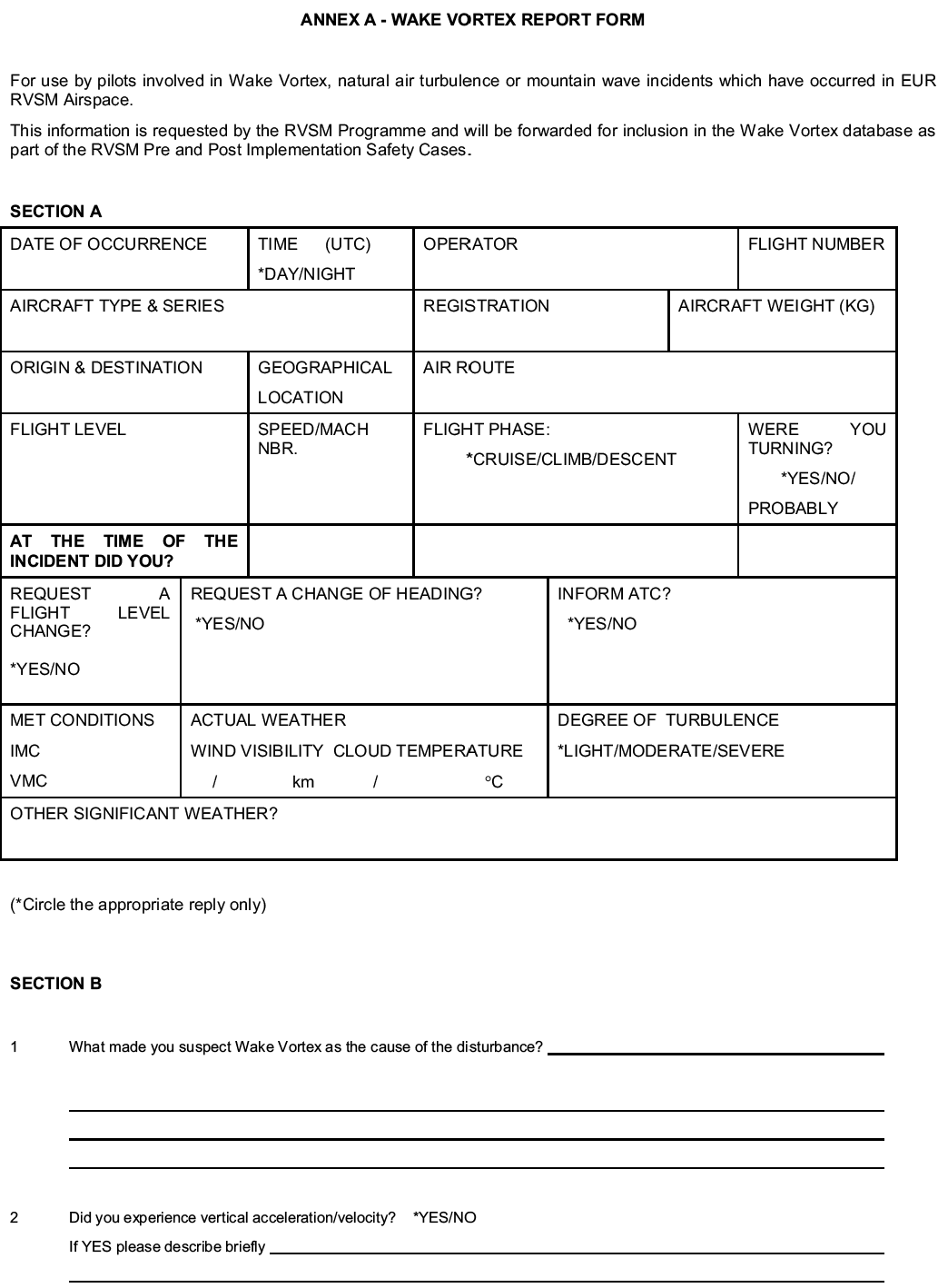
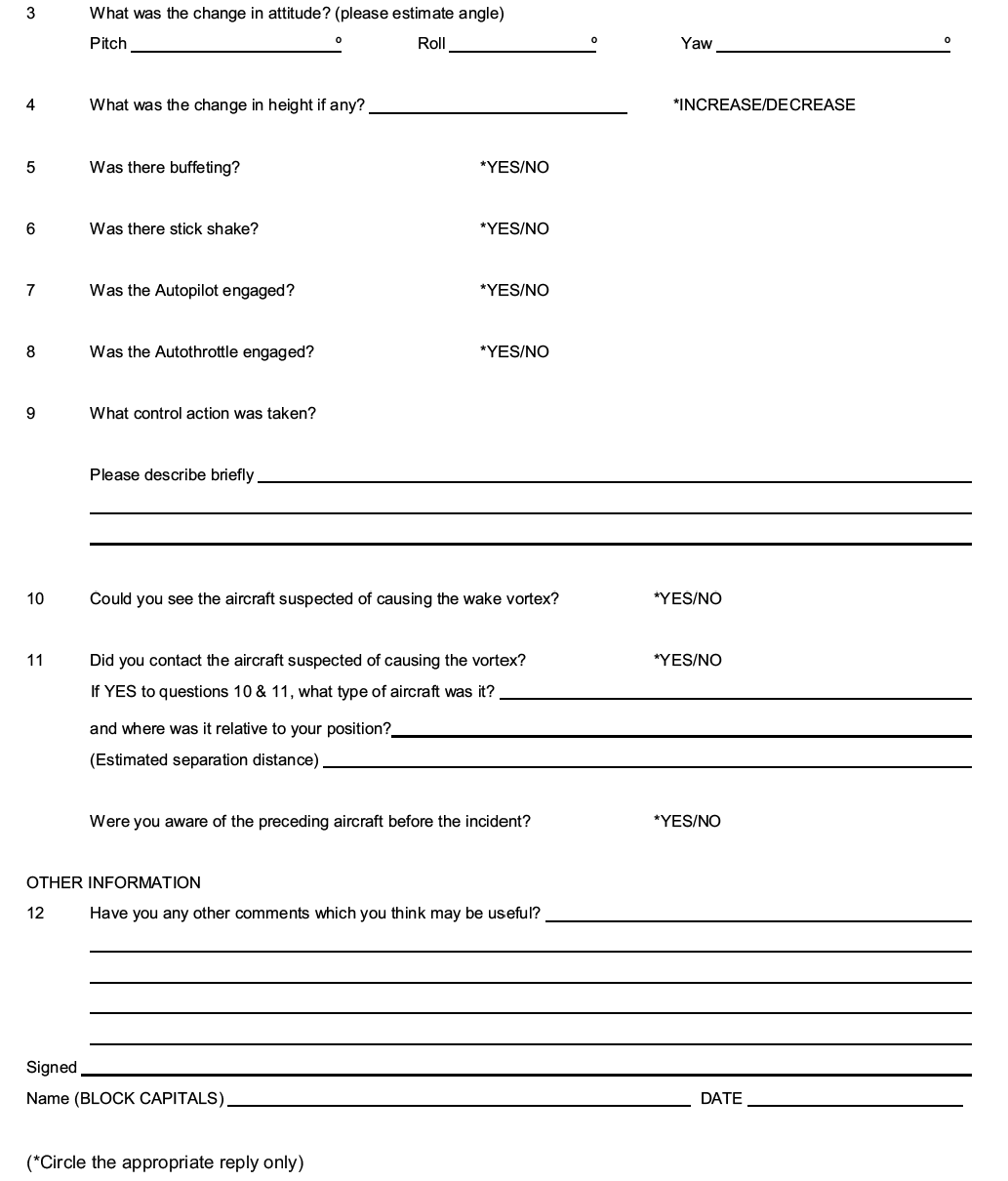
When complete please send this form to:
RVSM Programme Support Office
EUROCONTROL
Rue de la Fusée, 96
B-1130 Brussels
Belgium
Telefax: +322.729.4629
E-mail: rvsm.office@eurocontrol.int
1.14.6 AIRBORNE COLLISION AVOIDANCE SYSTEM (ACAS) MONITORING
1.14.6.1 Pilot procedure
1.14.6.2 Responsibility for separation of aircraft during manoeuvres in compliance with an RA
The ICAO Air Navigation Services ATC provisions for ACAS equipped aircraft are contained in PANS−RAC (Doc 4444). The use of ACAS does not alter the respective responsibilities of pilots and controllers for the safe operation of the aircraft.
1.14.6.3 ACAS II implementation monitoring
The continued contribution of operational personnel who take the time to complete and return RA report forms is essential because it provides the only reliable means to monitor the ACAS implementation and to assess the operational performance of improved TCAS II software versions in the European airspace environment. The maintenance of a database of RA events in the North Atlantic (NAT) Region is vital to enable the continued assessment of the operational implications of RAs in the European airspace. In addition, it is also necessary to assess operational implications of RAs in the NAT Region airspace particularly in view of the planned implementation of Reduced Vertical Separation Minima (RVSM). For these reasons, flight crew and controllers are encouraged to report all RAs, and if appropriate TAs, including those which occur in the NAT Region.
Specimen ACAS RA report forms for pilots and controllers are attached at Annexes A and B respectively.
1.14.6.4 RA reporting procedure
Aircraft operators and ATS authorities are requested to despatch complete ACAS RA report forms to the:
EUROCONTROL Experimental Centre
ACAS Implementation Monitoring
BP 15
F-91222 Brétigny-sur-Orge
Telex: aireuro: 602150f
Telefax: 00 331 60 85 15 04
SITA: PAREUCR
-
Air Accidents Investigation Institute
(See GEN 1.1.11)
-
Civil Aviation Authority
(See GEN 1.1.1 b)
Individual data will only be used for ACAS analysis and will be treated as confidential. Note that RA reporting should be used independently of AIRPROX and other incident reporting procedures, which remain unchanged.
Annex A
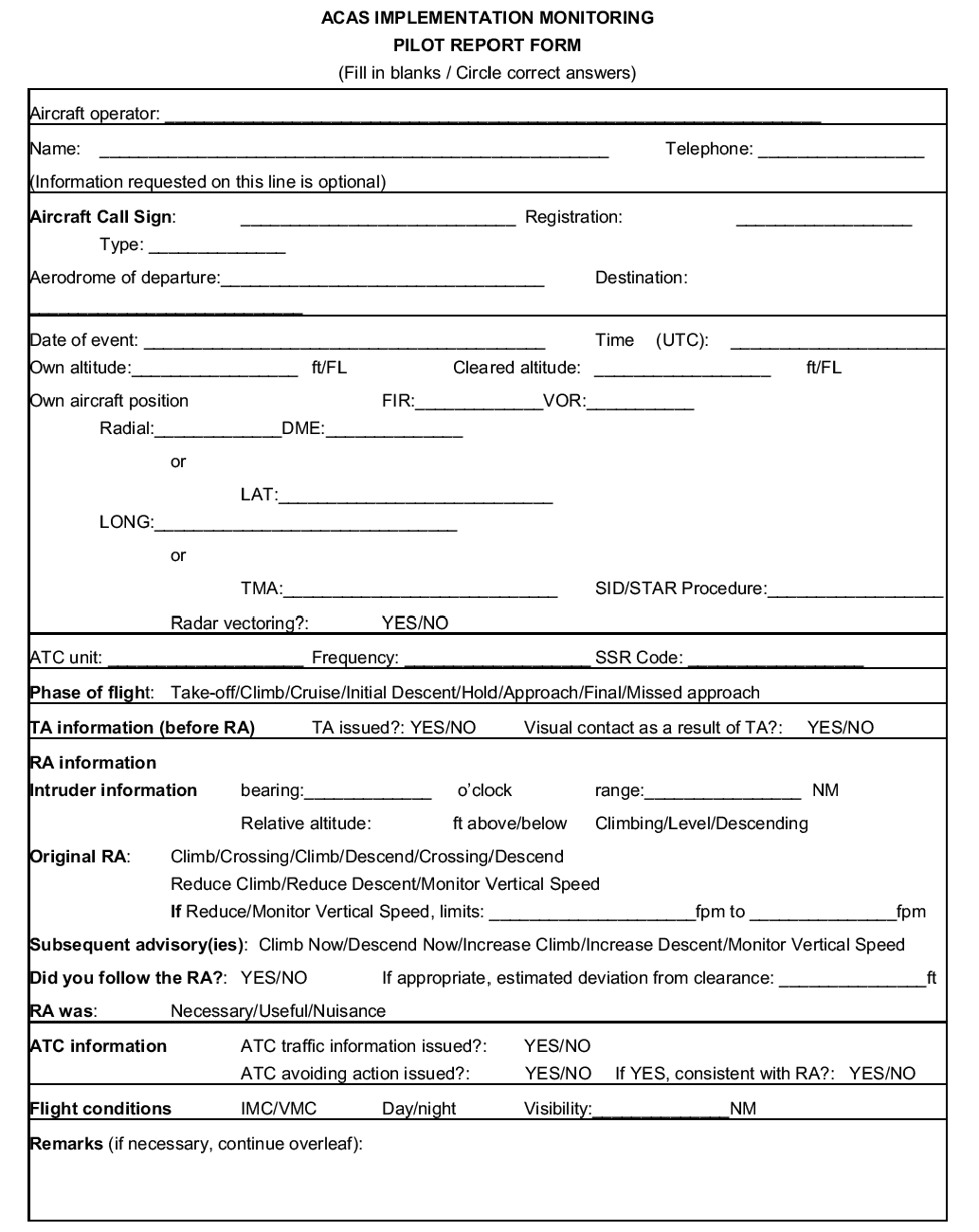
Annex B
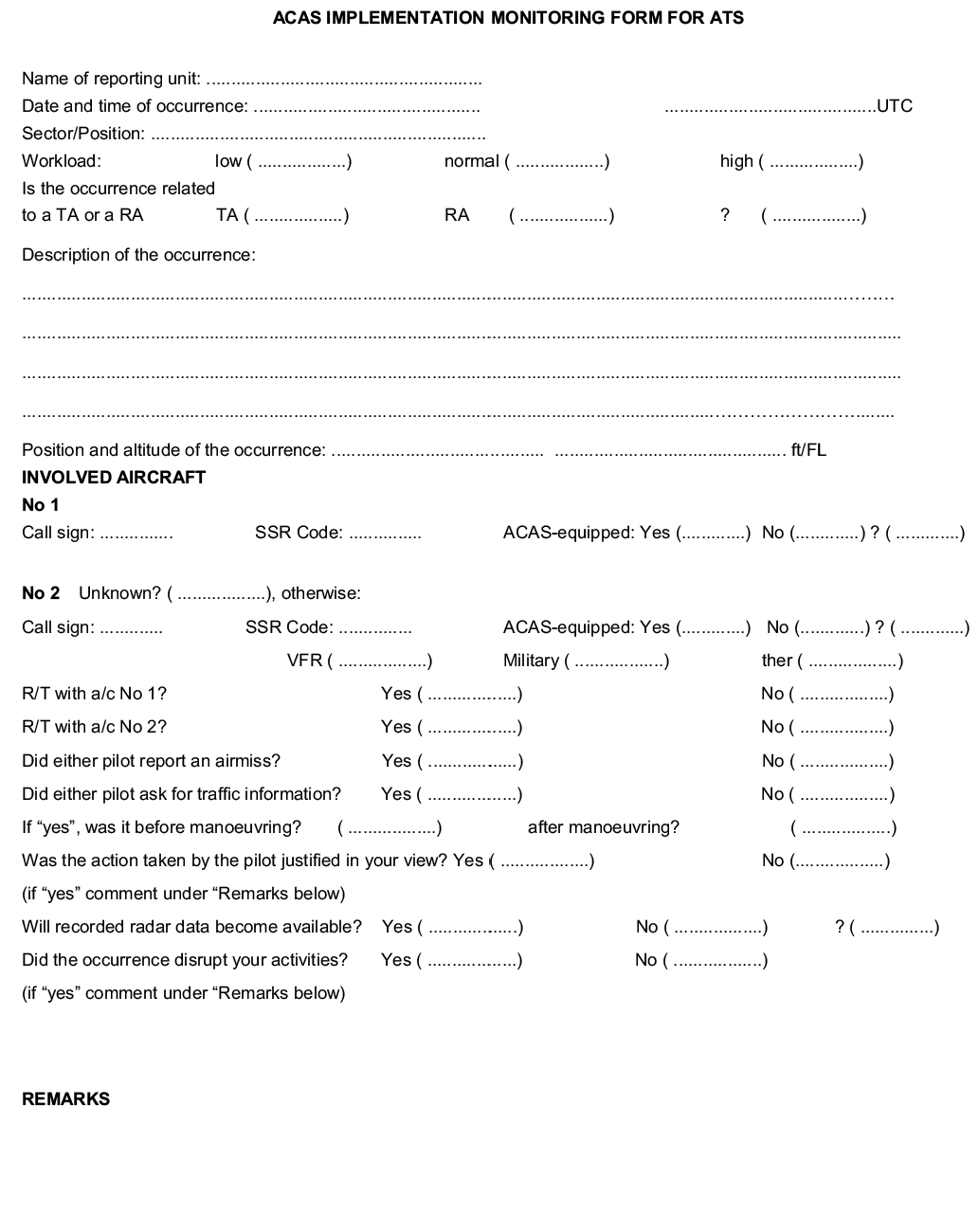
1.14.7 BIRDSTRIKE REPORT
1.14.7.2 Supplementary Bird Strike Reporting Form operator costs and engine damage information
Maintenance personnel should complete this form.
1.14.7.3 Reporting procedure
Aircraft operators and ATS authorities are required to despatch complete report forms to the:
-
Air Accidents Investigation Institute
(See GEN 1.1.11)
-
Civil Aviation Authority
(See GEN 1.1.1 b)

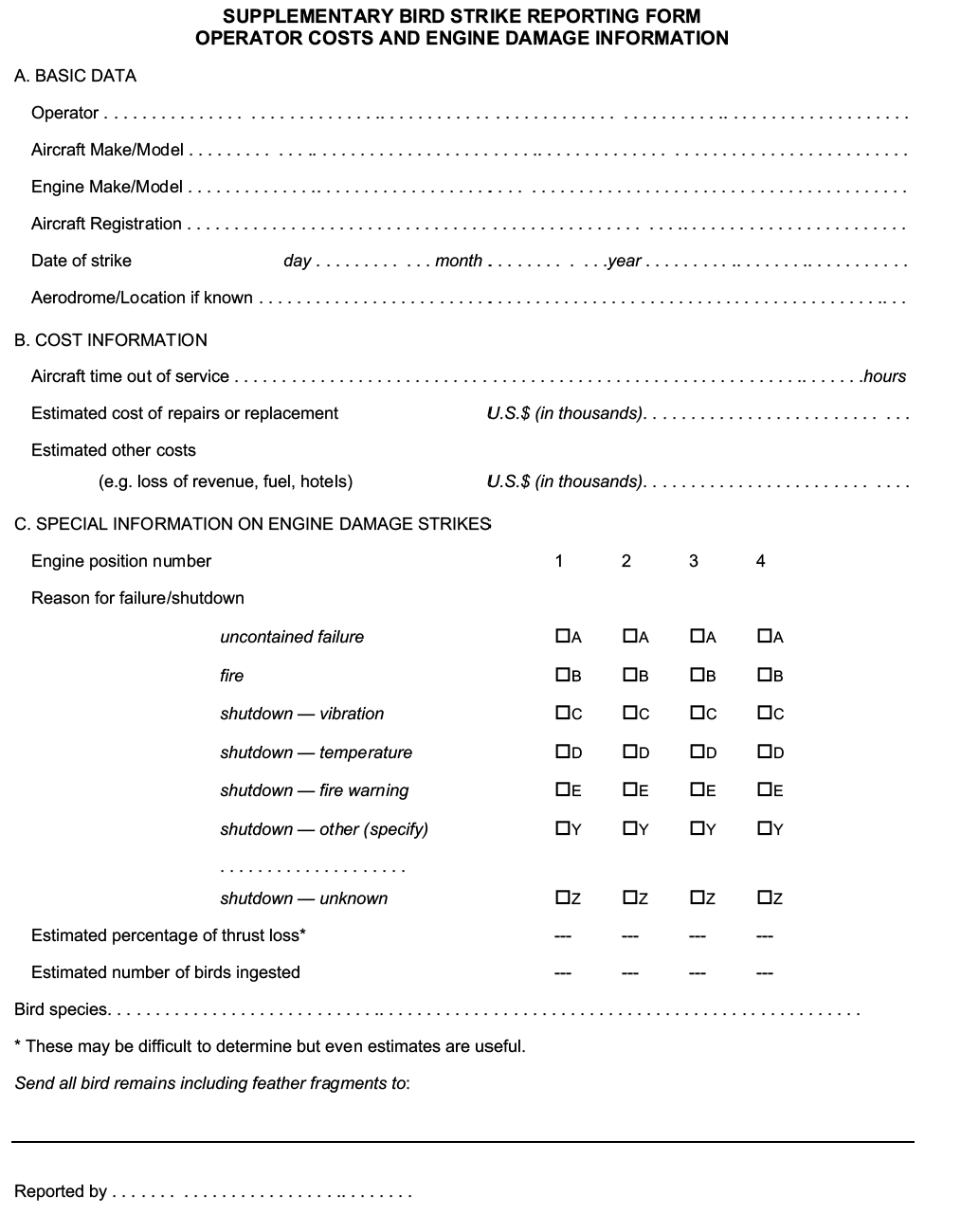
1.14.8 LASERSTRIKE REPORT
protect own sight; turn away from the light source; consider the possibility of using the sun shields or turning on the cockpit/cabin/workspace lights for contrast reduction; do not look for the dazzling source (but remembering of at least approximate source position may help the investigation);
consider the control transfer to the undazzled pilot;
record the aircraft position in the moment of dazzle, i.e. immediately use squawk IDENT or other available position recording equipment, e.g. recorder (EVENT) or GNSS receiver;
pass the information about dazzle together with the estimated light source position, if recorded, according to the following procedure:
a flight attendant receives a potential report from a passenger;
a cabin service manager receives the report from the flight attendant;
the cabin service manager reports the information to a pilot-in-command;
the pilot-in-command passes the information to the actually contacted ANS unit;
the Area Control Centre ANS unit passes the information to the Police of the Czech Republic Operational Centre at phone number +420 974 834 001; the Approach/Tower ANS unit passes the information to the local department of the Czech Republic Police together with following information:
the exact time (UTC) of the dazzle;
the flight callsign;
the aircraft level during the dazzle;
the geographical coordinates (WGS84) of aircraft position during the dazzle, possibly including the light source position or the geographical name of the locality as reported by the crew;
the runway in use (in case of arrival or departure);
if a tower air traffic controller registers a dazzle he/she passes the information to the senior controller, who may decide possible restrictions in provision of the air traffic services and informs the local department of the Czech Republic Police and the airport operator;
if sufficient information about the light source position is available or if requested by the pilot-in-command or senior controller, the appropriate ANS unit passes this information immediately to the Czech Republic Police together with the request for investigation launch.
if aircraft is dazzled on its arrival to the Czech Republic, the appropriate ANS unit passes to the Czech Republic Police the information of airport of arrival and estimated time of arrival (ETA) for facilitating the supplementary information acquisition after arrival from the pilot-in-command and prospective observer.
In case of overflying aircraft or aircraft departing from the Czech Republic the aircraft operator passes the incident report to the Czech Republic Police after arrival.
1.14.8.4 Usable contact information
Police of the Czech Republic
Service of the Police Presidium
Inspektorát cizinecké policie Praha – Ruzyně
ul. Aviatická 1050/16
P.O. BOX 30
160 08 Praha 6
Telephone: +420 974 841 219 - secretariat
Telephone: +420 974 841 446 - border check department
Telephone: +420 974 841 947 - operational centre
Telephone: (Praha/Ruzyně airport local line: 4444)
Telefax: +420 974 883 579
E-mail: iaprg@mvcr.cz
